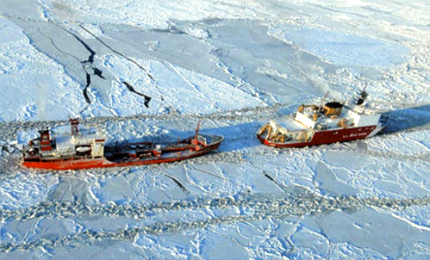Overview
Naval Vessel Ice Capability Optimization Effort (2011-461)
Project Team:
- General Dynamics NASSCO
- General Dynamics Bath Iron Works
- American Bureau of Shipping
May 2011 - May 2014
NSRP ASE Investment: $901K
Industry Investment: $890K
Objective:
Develop analytical methods and templates to meet a range of ice capability requirements for a variety of generic ship types/classes.
Summary:
In response to an increasing demand for ice class naval and commercial vessels, the International Association of Classification Societies (IACS) has developed a new set of Polar Class rules, called Unified Requirements for Polar Class Ships (IACS Polar UR). The IMO Guidelines for Ships Operating in Polar Waters, which reference the IACS Polar UR, are expected to become a mandatory Polar Code in the near future. ABS has decided to replace the ABS general ice classes A5-A1 with the IACS Polar Class (Polar Class) in the 2012 ABS SVR, and retain the ABS general ice classes A0 through D0 (First-year Ice Class), and the Finnish Swedish Ice Class Rules (Baltic Class).
The goal of this project is to develop a better understanding of the structural design implications of the different non-icebreaker ABS ice classes, and allow designers and engineers to quickly converge on an optimized design that fulfills the ABS requirements for ice class vessels. The project will develop computer spreadsheets/templates to allow easy and fast interactive evaluation of different structural arrangements that satisfy the ABS Ice Class requirements. Scantlings for various government and commercial vessel designs will be compared across the classes with the goal of understanding the structural differences and the relative cost associated with increasing a vessel’s ice strength.
Generic computer templates addressing the scantling requirements of the ABS 2012 Ice Class Rules (Baltic and First-year Ice) have been created and evaluated by ABS to ensure they meet the intent of the ABS Rules. In the next phase, the project team will apply the templates (including the ABS developed Polar Class template) to define the baseline ice belt structural requirements for a typical single skin ship. Phase III and IV plan to investigate and apply the templates to define the baseline ice belt structural arrangements for double-skin ships, and ships with light scantling high density arrangement. Concurrently, a cost estimation methodology will be developed to provide the tools for a convenient cost – ice capability assessment of various ABS compliant ice belt structural arrangements.
Key Deliverables:
Project Results Summary – Approved for public release; distribution is unlimited
Request Final Report from NSRP – Limited Distribution authorized to U.S. shipbuilding and repair industry and NSRP ASE Program representatives
Point of Contact:
Ian Busch, General Dynamics NASSCO
